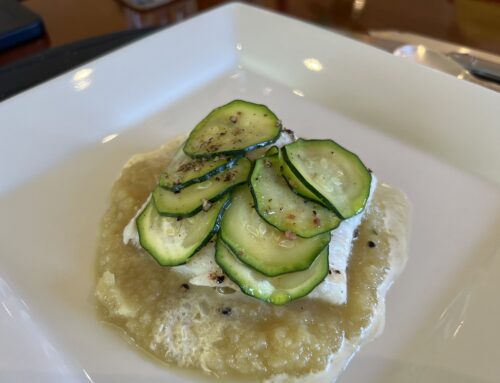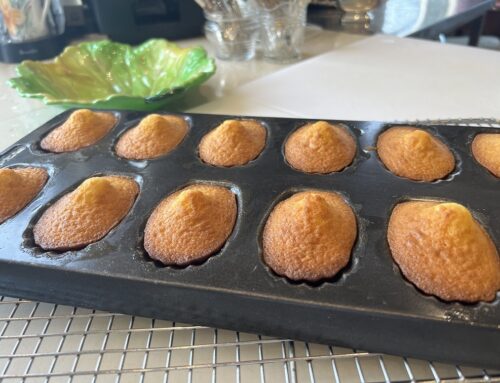This brown beef stock recipe forms part of my Mastery in the kitchen – the foundations of cookery – Stocks, sauces and soups program.
To be a good cook you need to master the fundamentals of cookery and stock-making is one of those. The best stock is full of flavour, colour, body and aroma. Good stock is the key to making sensational sauces that enliven your dishes and is the basis for all good soups.
It is well worth the hour you take to prepare the ingredients, to chop the meat and vegetables and then to cook them. Then you set the pot over a gentle heat and let it quietly bubble away. You will enjoy the result each time you make your next stew, ragout, braise, soup and sauce.
Brown beef stock is a dark, rich and flavourful stock that is perfect for braises, sauces and soups, dishes such as braised beef cheeks, beef ribs, sauce Espagnole and demi-glace, and the famed onion soup, where you are building depth of flavours. It involves the technique of deglazing to add as much flavour and colour as possible to the stock. Ask the butcher to chop the bones quite small, so they fit into the baking tray and also to maximize the surface area of the bones to increase the flavour of the stock.
Makes 2 litres
The beef
2kg chopped beef bones
350g oxtail, sectioned
1kg diced shin beef, osso bucco or gravy beef
Mirepoix
2 onions
2 carrots
4 celery stalks
2 leeks
The flavourings
250g tomato, optional, peeled, seeded, chopped; cook until all the juice has evaporated
250g mushrooms, optional, cleaned, chopped; cook until all the juice has evaporated
Bouquet Garni
3 bay leaves
sprig of thyme
parsley stalks
Preheat the oven to 190°C.
To cook the bones and meat: place the bones* in a single layer on the roasting tray. Do not overload the tray or the bones will sweat and not brown. Roast in the hot oven for 1 hour, turning them every 20 minutes to brown well. Roast until they are a light brown colour.
Do not over-cook the bones as the calcium will start to leach from them and the stock will become cloudy and bitter.
Clean and cut vegetables into even-sized pieces, using mainly the white part of the celery or leek; set aside.
Meanwhile, heat a thin layer of oil in the pot, and when hot, cook the oxtail and diced shin meat in small batches, colouring it deeply without burning. Remove and set aside.
To cook the stock: put a little more oil into the pan, add the mirepoix; cook on medium to high heat until lightly caramelised, and the sugars are browned. Stir regularly to prevent the vegetables from catching on the bottom of the pot and burning. This could take about 45 minutes.
Remove the meat and mirepoix to the stock pot. Pour a little water into the pot to deglaze it and add to the stock pot.
Once the mirepoix is browned you can add the tomatoes, mushrooms and star anise. Remove the bones from the oven, discard any fat and add the bones to the stockpot. Add enough water to just cover it all and add the bouquet garni.
Bring the pot to a very slow simmer, ‘a lazy bubble’, where a few bubbles break the surface every few seconds. Never boil the stock. The reason: any more than a lazy bubble and you will emulsify the fat into the stock and to stir up the impurities. We want a clear stock and not a cloudy one.
Keep the pot cooking at this lazy bubble for 6-8 hours; gently skim the surface frequently to remove the impurities. Strain the stock carefully. Skim off all the fat before you cool the stock.
Degrease by removing the fat from the surface of the stock with a spoon; then draw paper towelling over the surface of the stock, repeating with fresh paper until all the fat globules have been removed.
Cool by decanting the stock into smaller bowls to cool quickly.
To store the stock: within 2 hours pour the stock into 250ml or 350m containers and refrigerate until cold, then freeze.
If you wish to reduce the stock for a more intense flavour, and requiring less freezer space, return the strained stock back into the pot and bring to the lazy simmer for a further hour or two. Then cool and put into the containers for freezing.
Remember:
Never boil the stock or stir the stock or it will become cloudy. Do not add salt.
It is best to freeze the stock if you are not using it within a day or two.
Quality characteristics:
Colour: brown and clear
Texture: free of fat
Consistency: gelatinous
Flavour: rich beef and caramelised vegetable flavour
Aroma: characteristic of the base ingredient
Bones*: small size, roasted to brown colour with mirepoix
* The younger the bones, the more connective tissue they have; connective tissue is largely made up of a protein called collagen; collagen melts into a substance called gelatine. Gelatine is a gluey protein that gives the stock body. The bones add most of the flavour, plus they give the stock body. The gelatine may set when cooled.
- Preparing the vegetable mirepoix
- Preparing the vegetable mirepoix 2
- Cooking mirepoix
- Lazy bubble for 6 – 8 hours










